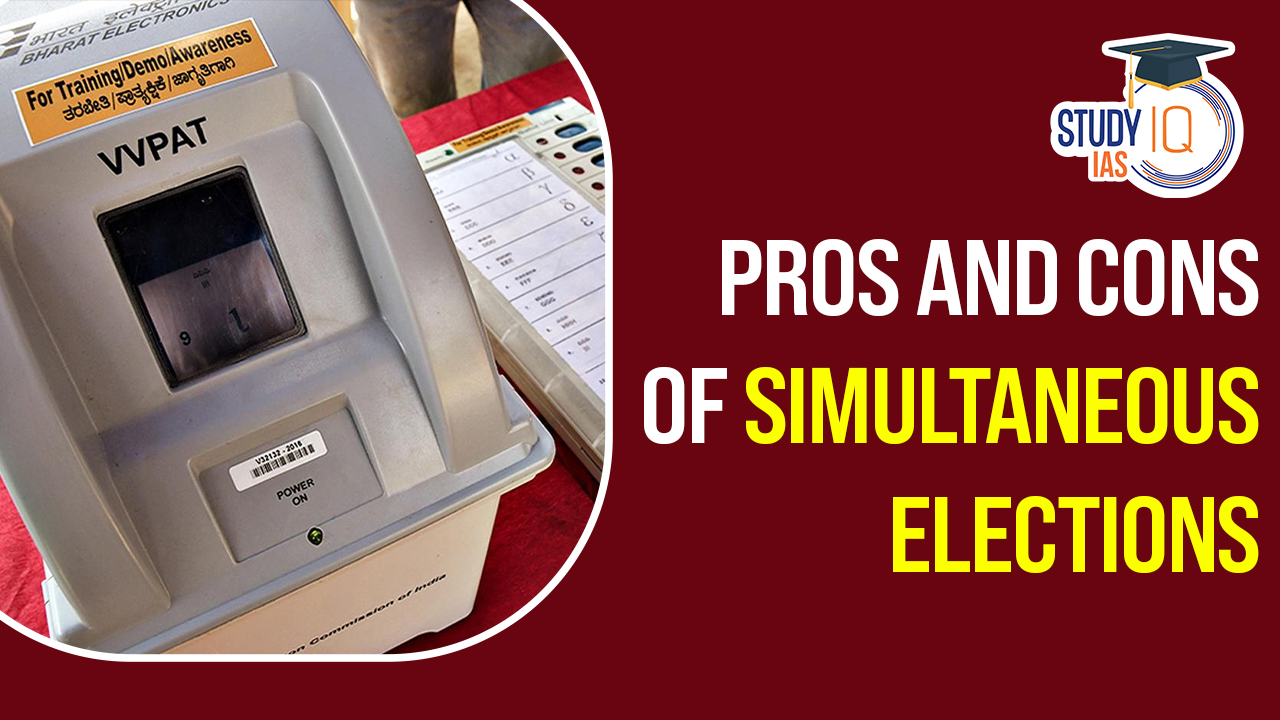Table of Contents
Context: A High-Level Committee (HLC) headed by former President Ramnath Kovind has invited responses on the proposal to hold simultaneous elections.
Simultaneous Election: An Overview
- What Is It?: Synchronised elections or one-nation-one-election
- Voters will cast their vote for electing members of the LS and the state assemblies on a single day, at the same time (or in a phased manner as the case may be)
- History:
- 1951-1967: Simultaneous elections held for Lok Sabha and all Vidhan Sabhas.
- 1968-1971: Disruptions due to:
- Premature dissolution of some state assemblies.
- Lok Sabha dissolution in 1970.
- Current: No further synchronisation of elections since 1967.
Advantages Of Simultaneous Election
- Cost Reduction: Lower the cumulative costs incurred by governments in conducting separate elections + Reduce the expenses of political parties and candidates.
- Focus on Policy: Ministers and parties free from constant campaigning can dedicate more time to policy making and implementation.
- Administrative Efficiency: Reduced electoral disruptions allow the administrative machinery to function smoothly and effectively.
- Resource Optimization: Paramilitary forces and other resources can be utilised efficiently, avoiding frequent redeployment across states.
- Policy Continuity: The Model Code of Conduct’s impact on development initiatives is minimised with fewer election periods.
- Social Cohesion: Less frequent polarising campaigns can potentially lessen social and communal divisions, especially online.
Challenges Associated with Simultaneous Election
- Federalism and Diversity: It may lead to national issues overshadowing state-specific concerns, which could undermine the federal structure of India.
- Impact on Regional Parties: National parties might gain an undue advantage over regional parties if national-level issues dominate the electoral discourse during simultaneous elections.
- Feedback Mechanism: Frequent elections serve as a feedback mechanism, allowing governments to adjust policies based on electoral outcomes. Simultaneous elections could limit this feedback, affecting governance and policy-making.
- Constitutional Amendments: Implementing simultaneous polls would necessitate amendments to the Constitution, particularly Articles 83, 85, 172, 174, and 356, to alter the terms and dissolution conditions of the Lok Sabha and State assemblies.
- Majority and Stability: The current parliamentary system allows for the dissolution of houses if the ruling party loses the majority or seeks early elections, which is at odds with the idea of fixed tenures required for simultaneous elections.
- President’s Rule: State assemblies can be dissolved under President’s rule (Article 356), which would conflict with the concept of fixed simultaneous terms for the Lok Sabha and State legislatures.
We’re now on WhatsApp. Click to Join
Recommended changes for simultaneous elections in India
Election cycles:
- 2-phased: Lok Sabha + half state assemblies, then remaining states after 2.5 years.
- Requires constitutional and legal amendments.
No-Confidence/Confidence Motions:
- Mandatory pairing: No-confidence motion only possible with a simultaneous confidence motion for an alternate government.
- Dissolution deterrent: Early-dissolved Houses replaced with interim ones serving only the remaining term.
- Encourages new government formation: Makes dissolving less attractive, promoting realignment efforts.
Bye-Elections:
- Yearly consolidation: All bye-elections held once a year.
International Examples:
- Fixed terms: South Africa, Sweden, Germany (cited for stable legislatures).
- Combined elections: South Africa (National Assembly + provinces every 5 years).
- Indirect leaders: South Africa (President) & Sweden/Germany (PM) elected by legislatures.
- No-confidence with successor: Germany requires electing a new leader during no-confidence votes.


 Maharashtra Bill to Curb Urban Naxalism,...
Maharashtra Bill to Curb Urban Naxalism,...
 India to Host First Global Conference on...
India to Host First Global Conference on...
 How Terror Networks Abuse Digital Tools
How Terror Networks Abuse Digital Tools





















